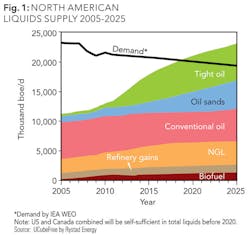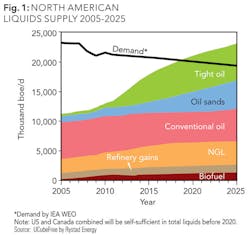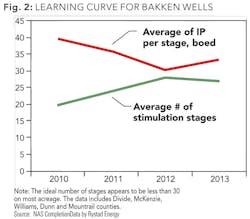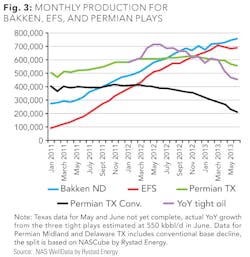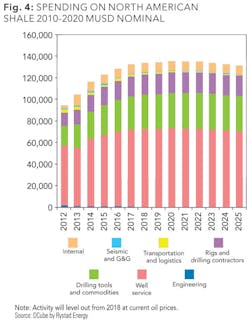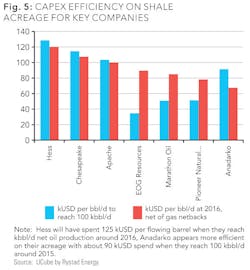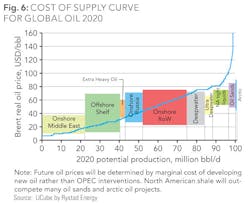Shale oil impacting global markets
The US and Canada combined will be self-sufficient in total liquids before 2020
Per Magnus Nysveen, Rystad Energy, Oslo, Norway
In this third article in a series, we discuss the key implications of adding eight million barrels of liquids from tight plays in North America from 2010 to 2020 (see references in May and July 2013 issues of OGFJ). Our previous articles have been acknowledged by the industry, academics, analysts, and officials on one side and even the best-informed shale skeptical bloggers and peak oil advocates on the other side.
Consensus is being established around this forecast given the key assumptions of flat oil prices and gradually decelerating activity as breakeven oil prices catches up with the initial learning curves. Our forecast is getting more "in the money" as the tight liquids production rate for North America passes four million barrels per day as you read this article (including NGL).
Monthly additions from the top three plays amounted to 50 kbbl/d per month for the second quarter of the year (excluding NGL), with 50% of growth coming from Eagle Ford and the remainder being equally shared between Permian Midland and Bakken (ref Rystad WellData). We now expect North Dakota Bakken oil production at the end of the third quarter to approach 800 kbbl/d if weather allows operators to reduce the backlog of completions that climbed after last year's winter storms and the recent Missouri flooding. (See Figure 1.)
Realistic assumptions
As we described in the previous article, the detailed assumptions behind our forecast are based on more than 1,000 different well production curves for the same number of specific acreage holdings, combined with a realistic assessment of expected well locations for each holding.
Future activity levels and trends are determined by physical and economic constraints expressed as full-cycle breakeven oil prices for each well location. In our comprehensive bottom-up model, any driller will secure rigs, spud, complete and connect wells to fill the local take-away capacity as long as the marginal well gives a return on well costs of more 10% at current oil prices. And we have seen that netbacks are considerably improved by associated rich gas in Eagle Ford and in the Permian and Anadarko basins' unconventional plays. (See Figures 2 and 3.)
A blessing for the global economy
The growth of shale oil coincides perfectly with the global struggle to recover from the 2009 recession. Despite the prolonged cooling of the developed economies and the surprise oil additions from North American tight plays, Brent spot has averaged 111 USD/bbl over the last 30 months. The longest period of comparable high oil prices was four months from May to August 2008.
The OPEC countries have not been able to sufficiently cool this prolonged overheating of the oil markets, as they may have done if they had more spare capacity. So without the rise of North American shale oil, there is no doubt oil prices would have peaked to cause demand destruction especially within the BRIC countries, the world's back-up engine for global growth. North American shale oil has thus been a true blessing for the global economy and also for several markets that commonly may perceive the shale oil revolution as a business threat, including offshore E&P, shipping, and even OPEC governments.
We believe the North American shale plays could overtake Saudi Arabia's giant Ghawar field and the Persian Gulf countries as the global swing producer, but for the next few years these unconventional plays, in the midst of oil-hungry Americans, are only swinging in the upwards direction as the majority of the new wells could yield triple-digit returns, and the wellhead breakeven prices are still below 60 USD/bbl for 90% of the wells being drilled in 2013 (ref Rystad NASReport).
Spending
E&P companies will spend 105 BUSD in drilling and completion on shale plays in 2013, up from 95 BUSD in 2012 and 45 BUSD in 2010. The strong growth of activities from 2010 caused a hike in prices for stimulation services, which again contributed to a slower activity growth from 2012 and more equipment available on the market, then lower service prices and now increasing focus by E&P companies on efficient operations. Well services make up about 60% of the overall D&C spending on North American shale plays. (See Figure 4.)
The service intensity for oil and gas developments is best illustrated by the cumulative spending required to reach a certain production level. For shale developments, spending is typically around 100,000 USD per flowing barrel (barrel per day). This is in line with oil sands developments and about twice as high as deepwater developments. But thanks to the relative short time between spending and production, shale development will give comparable returns and breakeven prices as compared to less service intensive deepwater developments. Early movers like EOG (100 kbbld reached in 2011) and Marathon (2013) actually spend two to three times less to achieve a certain production level than their peers Hess (2016) and Apache (2015), which arrived later to the tight oil game. (See Figure 5.)
Profits
Companies are still in an initial development phase for North American tight oil plays with total spending still surpassing the sum of netbacks. We estimate the total net "cash drain" on shale plays was ÷41 BUSD in 2012 vs. ÷11 BUSD in 2013, operated cash flows should turn positive during early 2014. Actually, aggregated cash flows turned positive for Bakken this year, for Eagle Ford in 2014, for Permian Midland in 2015, Permian Delaware in 2016 and for Marcellus not before 2017.
Transactions
During 2012, more than 120 BUSD was paid for acreage or companies active on North American onshore, or about 50% of the global transaction market. So far in 2013, the transaction market has cooled down, with about 30 BUSD paid for North American onshore assets, still about 50% of the global market for the year.
Global E&P
The global oil market has over the last decade changed from being supply-driven by OPEC quotas into an increasingly more competitive and demand-driven commodity market. This implies that global oil prices are being increasingly determined by the marginal cost of developing new oil. The addition from North American tight plays of six million barrels of crude oil and condensate will obviously push out some marginal developments, this will first of all impact high cost developments like Canadian oil sands, oil from Arctic regions and to a lesser extent mid-sized deep-water projects. (See Figure 6.)
Global shale
We believe there is a limited potential for replicating the North American shale success in other regions of the world. Our argument is based primarily on geology, even though there are numerous non-geologic challenges as well. The most proven shale formations in North America are all marine sediments deposited in tropic waters from Devonian (Bakken) to Cretaceous (Eagle Ford) in anoxic conditions in deep waters of the Western Interior Seaway. The pre-historic volcanic arc that today makes up the Rocky Mountains protected the ocean bed from ocean currents rich in oxygen. High content of silica or calcite versus clay make these shales exceptionally brittle while also sufficiently rich in organic content. Also, the movement of the pacific tectonic plate has not folded these organic shale beds as we see in many other petroleum basins.
In other parts of the world, including China, proven source rocks appear more heterogeneous or less brittle: Lacustrine shales (Northwest China), Fold belts (Eastern Sichuan, Yangtze platform), Over mature deep shale (Sichuan Paleozoic shales), Syn-rift formations with faults and natural fractures (Northwest China), too shallow shales with low pressure (Southeast China).
We still believe the industry could spend up to $100 billion per year on exploration and piloting global shale within some decades from now, but profits will hardly defend those investments before we are heading into the photovoltaic age.
Shipping
The sudden raise of North American tight oil will displace MENA region oil exports of 2.5 Mbbl/d to North America towards East Asia, which is a 2/3 shorter shipping distance. From 2016 we expect only about 1 MMbbld of Saudi heavy oil will still be shipped westwards to feed Gulf Coast cokers. Domestic demand for oil in North America will fall by 2 MMbbl/d over the next decade and US refineries could export the glut of about 1 MMbbl/d of gasoline to Europe.
Adversely, 2 MMbbl/d of US oil imports from South America will be displaced towards East Asia, a far longer sea route. Consequently, we believe the net effect on global shipping will be far less dramatic than previously feared. Actually the balance may even tip in a positive direction as the cost of shipping crude across the globe is actually lower than the crack spreads.
Final remarks
The North American shale revolution is a blessing for the global economy because it contributes to stabilizing oil prices. This will enable billions of more people in the emerging world to benefit from continued economic growth. Tight oil also displaces less environmental friendly oil, like kerogen and oil sands mining and Arctic developments. Warming the economy and cooling the globe, isn't that exactly what we need?
About the author
Per Magnus Nysveen is senior partner and head of data analysis for Rystad Energy in Oslo, Norway. He joined Rystad in 2004 and has particular expertise as an upstream portfolio and transaction advisor as well as wide experience with financial and fiscal regimes globally. He is also responsible for valuation analysis of unconventional activities and is in charge of the North American shale analysis. Per Magnus has developed comprehensive models for production profile estimations and financial modeling for oil and gas fields. He holds an MSc degree from the Norwegian University of Science and Technology and an MBA from INSEAD in France.
